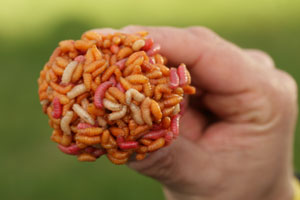Maggots Q&A
How are maggots coloured?
Maggots are naturally white and are generally coloured by eating meat that has already been died. The dyes used to colour the meat include rhodamine (for fluoro maggots), auramine (for yellow maggots) and Sudan Red (for red maggots). Although the first two are carcinogenic, because the dye is within the maggot the danger to the angler is thought to be limited. It should be noted that following its research into red maggot dye, the Dutch Angling Federation banned the used of all coloured maggots in Holland and is calling for a European wide ban.
Is chrysoidine still used?
The bronze maggot dye chrysoidine is also carcinogenic but the big problem with the use of this dye is that it’s used to coat the skin of the maggot and thus rubs off on the skin of the angler in use. The death of Clive Smith in the 1980s was closely linked to his regular use of chrysoidine and many anglers out there think it has been banned. However, all that happened was that suppliers of the dye like ICI discouraged its use in angling, and it is still available. Although leading suppliers of maggots and pinkies now use a bronze dye alternative called Methic Orange, there are many tackle dealers and some suppliers out there who still use chrysoidine to dye their own bronze maggots and if you are in any doubt, you should ask. So-called ‘disco pinkies’ used commonly in the east of England are pinkies raised on rhodamine dyed meat and then skin-dyed with chrysoidine.
Can they be flavoured?
The answer is yes but it’s a painstaking process as you have to do it over a few days so they absorb the flavour. A flavour we recommend is Scopex and you need some with a vapourising spray attachment such as the Crazy Baits Flavour It from Sensas. The maggots need to be kept in quite a shallow tray so spread them out and then sprayed a couple of times a day for about a week prior to using them. The maggots then absorb the flavour through the skin gradually. The best bet is to do this morning and evening. Four or five squirts is enough but try and cover the whole tray and let them coat each other as the wriggle about before adding maize so that you can prevent them from crawling out. You’ll have to keep riddling them to remove any lumps, dead maggots and casters. Powdered flavours like turmeric can also be used, but just letting the maggots crawl in turmeric is not that effective. What you have to do is make them sweat to take on the flavour, then cool them down. Do this over two or three days, but no more or the maggots go off.
Why are dead maggots effective?
The first benefit of dead maggots over live is as a feed bait. Live maggots, squatts or pinkies wriggle under the water and will soon disappear into silt and debris on the bottom. If you feed dead maggots you know that you have an area of bait working for you until a fish happens along. In situations where you may have to wait a long time for a bite, this knowledge is very important to the angler. You know there’s bait there and are not tempted to overfeed – you can simply feed for every fish. As a hook bait dead maggots are very commonly used on commercial fisheries with The Method, although not all anglers understand why they are so effective. The reason is almost certainly not in the attractiveness of the dead maggot hook bait itself, but in the fact that it’s so light, and so easily sucked into the carp’s mouth as it feeds on the groundbait. For how to make perfect dead maggots (see below).
What about maggots on commercials?
On mixed commercials with a big head of silver fish, using maggots is a recipe for getting a bite a chuck from small fish but struggling to contact the better fish. That’s where baits like sweetcorn and pellets come in, which are less likely to be taken by the smaller fish and therefore give you a better chance of the better fish like carp and tench. Having said that, carp will barge out smaller fish if they get a taste for maggots and so-called ‘speed feeder fishing’ where a maggot feeder is cast every couple of minutes can produce big bags of carp in summer. When commercial carp fisheries first opened spraying maggots and waggler fishing with maggots shallow for them was a popular technique, but this has now been superseded by shallow pellet fishing. In the cooler months maggots are a key bait on commercials and there are times in winter when maggots will be taken more readily by F1s and carp than any other bait.
Maggots for big river fish
The trick to catching big river fish on maggots is knowing when to fish them and when not to. On rivers in summer there will be lots of small fish like minnows active and maggots will be constantly attacked by them. Unless you fish a very large bunch, it’s hard to fish maggots at this time. The way around it is to feed heavily with maggots and watch the swim. When the big fish like chub and barbel move in, the small fish will be ‘outa there’! In winter these small fish seem to all but disappear and maggots can be fished effectively. Indeed in low, clear conditions on rivers, bunches of maggots tend to be more effective for specimen fish like barbel and chub than the pellet based baits that seem to dominate these days. A good tip if doing something like this is to add a sliver of rig foam shaped like a maggot so it sits up like a Red Indian’s headdress. Other anglers tie a hair to the bend of the hook from very light line (1.5lb) and Superglue a bunch of maggots to this (see page 18). Overall the colder the water is, the less effective fishmeal will be and the more you should look to use maggots. That said, if the water is coloured you are better fishing a large, smelly bait like meat or pellet.
Maggots on canals
You tend to associate squatts and pinkies with this sort of venue but canal fishing has changed and there are a lot more big fish to go at these days. If you are pole fishing, feeding a big pot of maggots down the track (the middle) at the start of the session can be very effective for quality fish like perch and eels. And if your venue holds carp these can also be caught this way, so rig up accordingly. Match anglers will tend to do this to one side away from the feed area but keep an eye on it. If they see bubbles coming up they will fish over it immediately as that means there’s a fish getting its head down on the bait. Maggots can also be chopped up to release the juices – this can be especially effective when you are after perch.
Keeping your bait fresh…
Always look to get the freshest bait you can from your tackle dealer – the size of the dark feed spot at the head end will tell you how recently it was taken off the feed. Also fresh bait is large and feels soft to the touch. This softness is critical when you are targeting fish like skimmers, dace and roach that won’t touch a tough, old bait. Also fresh, soft maggots tend to drop through the water at a slightly slower rate than a tougher, older bait. This is important if you are fishing on-the-drop style or long trotting on rivers. So in a nutshell, fresh is best! To keep the bait as fresh as possible, run your maggots through a riddle to get rid of any dead maggots and skins and put into a clean bait tub with some fresh maize. Then store in a cool, dry place like the concrete floor of a garage or if you have one a bait fridge. In winter you can keep maggots in tip top condition for a week, in summer probably three days. Sawdust can also be used to keep the maggots in. This is good if they are likely to sweat up as the sawdust soaks up the moisture. However, the sawdust will tend to toughen the skins up.
Floating Maggots
Maggots can be easily made to float. Take a bait tub and cut out the centre of the lid. Add just enough water to nearly cover a maggot and then add a few maggots. They will take on air in the head (you can see a bubble of air) and this makes them float. This takes about 15-20 minutes and as long as you keep the lid on, the maggots will keep on crawling up the side and falling back into the bait tub. The process can be speeded up to a couple of minutes by using a fizzy drink instead of water (see page 126 of our October 2006 issue). Floating maggots will sink once you put a hook in them, but do so very slowly, giving a superbly natural on-the-drop presentation. Fished on the bottom, they are very easily wafted up and grabbed by any passing fish.
Colour Coding
Our rundown of the most popular colours of maggots, pinkies and squatts and when to use them.
 |
White Maggots
The standard colour of a maggot without any dye. Maggots are the larvae of the bluebottle and catch fish of all species. Interestingly white is the colour generally used by big fish anglers for night fishing, including those targeting specimen roach on gravel pits. |
|
 |
Bronze Maggots
The classic river bait for fish like chub, dace and roach – an all-time favourite on rivers right across the country. Bronze pinkies are also very popular with silver fish anglers who fish the drains of the east of England. Adding turmeric to white maggots will give them a bronzy hue and an extra spicy kick. |
|
 |
Red Maggots
There is no doubt that the colour red appeals especially to predatory fish and red is the colour to use if you are after perch. It is also an excellent bait on all waters for carp, tench, bream and skimmers. Red maggot seems to be a better bait for fishing on the deck – fish seem to be able to pick them out against a dark bottom. |
|
 |
Fluoro Maggots
Quite new on the scene, these are like giant pinkies and make a great change bait to try and pick off the bigger fish in the swim when feeding squatts and fishing pinkie over the top or when feeding pinkies. |
|
 |
Pinkies
The pinkie is about half the size of a maggot and is the larvae of the greenbottle fly. Available generally in white, red, bronze and fluoro pink, the latter being particularly popular with silver fish anglers on canals and drains. |
|
 |
Squatts
The larvae of the housefly is about half the size of a pinkie and usually available in red and white. Commonly used loosefeed for silver fish match anglers and also brilliant fed in groundbait when you are laying down a bed of bait for bream and skimmers and need to hold a shoal of them in your swim. |
|
All Hooked Up
And you thought hooking maggots was straightforward! Here are eight options to help you put more fish on the bank.
 |
Hooked Normally
This is the correct way to hook a maggot under normal circumstances, with the hook point nicked at the thick end of the maggot ‘between the eyes’. The most important part of hooking maggot is to make sure it’s not damaged in the process. If it is, take it off and start again. |
|
 |
Double Maggot
When you hook two maggots together ‘normally’ they will push apart making a ‘v’ that creates line spin on the retrieve and makes it harder for a fish to get them both in its mouth. To overcome this, when fishing double maggot one of them should be hooked ‘upside down’ through the pointed end. |
|
 |
Double Dead Maggot
Dead red maggot is a highly popular and effective hook bait when used in conjunction with The Method. You can use single maggot, but if there are small fish around double maggot is better and because the dead maggots are limp you can hook them both normally. |
|
 |
In The Side
If you watch maggots sink through the water you’ll see that they do so side-on rather than one end going down first. So when fishing on-the-drop style, some anglers nick the hook through the side of the maggot to try and mimic this presentation. |
|
 |
Maggot Klip
If you fish bunches of live maggots, very often one of them will cover the point of the hook, causing you to miss bites and lose fish. This little device from Korda is a clever way of presenting a bunch of maggots while still keeping the whole of the hook point free to maximise hook-ups. |
|
 |
Threaded Single Maggot
If you are catching a lot of small fish quickly especially when using a whip, fishing a tough-skinned maggot or pinkie threaded onto a small hook can see you catch a lot of fish without having to change hook bait. You can toughen them by leaving in coarse sawdust for a week. Use a long-shanked hook. |
|
 |
Threaded Double Maggot
This method is used by some float anglers who target wily old chub. The idea is that you are masking quite a bit of the hook shank and also creating a large, long bait that can easily be seen as it races through the swim. Use a wide gape size 14 hook so there’s plenty of the point free. |
|
 |
Hair Rigged Maggot
Tie a two-inch length of low diameter line (about 1.5lb) to the bottom of the hook and then hold the maggot still and Superglue the line to the side if it. Then hold the glued maggot and glue a second maggot to this and so on. When finished, trim any line below the bait. It’s a messy business but because there no added weight in the bait itself (such as a hook or Maggot Klip) it will waft off the bottom naturally as fish pass and can be deadly. Because the hook lies flat on the bottom, there is also little chance of foul-hooking fish. |
|
Sticky Situation
When groundbaits are not an option and blockend feeders are too slow to distribute bait quickly there is another way, sticky maggots!
There are times when fishing with maggot hook baits on a commercial venue that you need to get a large quantity of feed down on the deck quickly to keep feeding fish tight in an area.
That’s not a problem when groundbait is allowed, but what do you do when it’s use is banned?
You could use blockend feeder tactics, but the problem with that is the bait tends to disperse from the feeder too slowly and you end up with fish attacking it rather than grubbing around on the deck and finding your hook bait.
A better option for getting the bait out onto the bottom is an open-end feeder, but how do you get the active bait to stay in until it reaches its destination? The answer is to use sticky maggots, or ‘stickymag’ as anglers call it.
This is a great way to fish maggots at distance, as the bait stays onboard until the feeder hits the deck and when it does land, moments later the feed explodes out and creates an active bed of freebies. And because the feed disperses quickly you can retrieve and recast with the knowledge that all the bait is out and you’re not leaving a trail of stragglers in the feeder’s wake, as is sometimes the case with blockends.
Sticky maggots are primarily used on commercial venues, but on fast, shallow river glides it’s a good way of getting a large portion of maggots to the bed quickly, so that a compact trail of freebies is carried downstream to attract species such as chub and barbel. You can add gravel to get the bait down quickly.
The added bonus of the maggots being sticky is you are able, if you get the stickyness right, to pack a lot into any size feeder, confident in the knowledge that they will not fall out when you cast.
There are a number of recipes for creating sticky maggots using concoctions from bait manufactures to everyday products like Horlicks. The best purpose-made ‘stickymag’ we’ve come across is made by Colmic.
The following sequence is the tcf team’s way of preparing them – you will need at least four pints of maggots.
 |
Step 1
The first job is to riddle the bait of and maize or sawdust. |
|
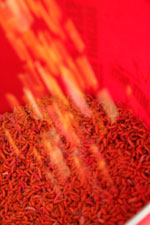 |
Step 2
Once cleaned, store the maggots in a clean, dry bucket. |
|
 |
Step 3
Although cleaned the bait still has a covering of dust… |
|
 |
Step 4
… so wet your hand a run it through the bait to remove it. |
|
 |
Step 5
You’ll be surprised at how much dust you get on your hand. |
|
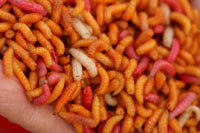 |
Step 6
Repeat the process a few times until the maggots look shiny. |
|
 |
Step 7
Now add some of the sticky maggot powder to the bait – not too much. |
|
 |
Step 8
Using a dry hand, work the powder in to get the bait well coated. |
|
 |
Step 9
You need to take a view now as to whether you need to add some more powder |
|
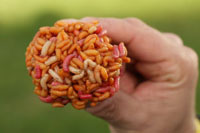 |
Step 10
Leave for about 15 minutes. When ready you should easily be able to form balls of maggots. |
|
 |
Step 11
Before loading the feeder, dip it in maize like this. |
|
 |
Step 12
This will coat the sides and stop water in the feeder breaking up the balls. |
|
Dead Certainty
The tcf team shows a simple and guaranteed way of making dead maggots on the bank without risking damage or losing the colour.
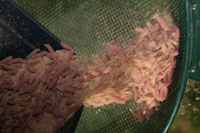 |
Step 1
Clean off the maggots using a riddle to remove any dust. |
|
 |
Step 2
Pour your cleaned-off maggots into a clean bait tub. |
|
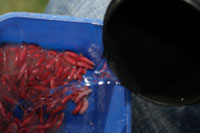 |
Step 3
Add cold water until there’s at least about an inch of it in the bottom. |
|
 |
Step 4
Now pour in hot water or tea/coffee from a flask GRADUALLY. |
|
 |
Step 5
Add the hot water a little at a time until all the maggots stop wriggling. |
|
 |
Step 6
A few of the dead maggots will float, remove these (they can be kept for the hook). |
|
 |
Step 7
Now drain off the water using your riddle. |
|
 |
Step 8
Superb dead maggots that have not stretched or lost their colour. |
|


